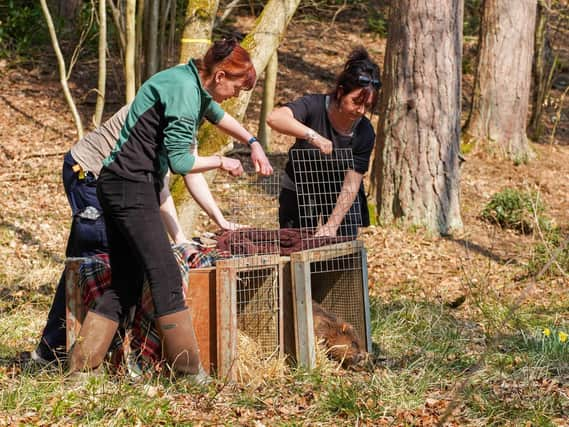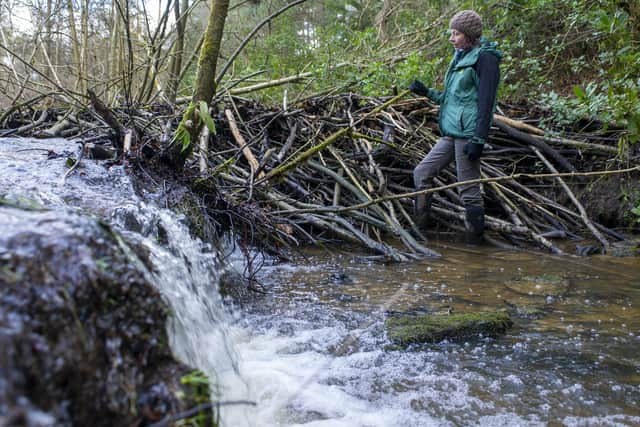Fears that government will delay reintroduction of beavers into Yorkshire


The Wildlife Trusts are backing a campaign to restore beavers in areas where they can help to prevent flooding and enhance the natural ecosystem.
The Eurasian beaver is native to Britain but was hunted to extinction around 400 years ago.
Advertisement
Hide AdAdvertisement
Hide AdThere are currently several small-scale reintroduction schemes in place around the country, including the relocation of two adults from a population in Scotland to Cropton Forest, near Pickering in North Yorkshire. They have since had two babies and the project has been hailed as a success by Forestry England ecologists.The Cropton Forest family live in a fenced, monitored enclosure but in other areas of the country, such as Scotland and Devon, the populations have been allowed to become wild.


More than 60 leading conservation organisations, country estates, experts and campaigners have called for an ambitious strategy to bring back beavers amid concerns over delays to decisions on the mammal’s future. A beaver strategy document expected to be published by the government in April has not yet been released.
A five-year project by Devon Wildlife Trust to study the role of the wild beavers on the River Otter in the county concluded earlier this year that they can live alongside people and deliver benefits for nature and communities.
The beavers build dams and make ponds that help reduce flooding, improve water quality, create habitat for other wildlife, and boost the local economy through eco-tourism, the study found.
Advertisement
Hide AdAdvertisement
Hide AdNow conservationists want to see DEFRA commit to a 'pragmatic and ambitious' strategy by the end of 2020 for restoring beavers in England to deliver benefits to landscapes and people.
In a letter led by the Beaver Trust, conservationists also called on ministers to ensure there is no moratorium on the 'current, effective' system of licensing beaver release projects and to speed up 'reasonable' applications.
A decision on the future of the River Otter beavers - which will affect other schemes - has been pushed back until August.
Owners of large country estates and conservation groups have applied for licences to keep beavers in large, securely-fenced natural areas, while community groups including local government are also planning wild releases.
Advertisement
Hide AdAdvertisement
Hide AdBeavers have come into conflict with farmers in areas of Scotland where they now roam wild, and are at risk of persecution, but capturing them and relocating them to managed projects in England will prevent this if applications are processed efficiently.
The letter is signed by groups including the National Trust, RSPB, Woodland Trust, the Wildlife Trusts and the Nature Friendly Farming Network, estate owners including the Duchess of Rutland, of Belvoir Castle, and others including TV presenter Hugh Fearnley-Whittingstall and entrepreneur Deborah Meadon.
The Wildlife Trusts has also written separately to the Government, urging it to produce a strategy that will set out the legal basis for beavers in England and regimes for managing the wild animals and their impacts.
The trusts, who have been at the forefront of moves to reintroduce beavers, also want financial support for farmers and landowners to make space for water and beavers on their land.
Advertisement
Hide AdAdvertisement
Hide AdWildlife Trusts chief executive Craig Bennett said: “Beavers are proving just what a valuable force they can be in helping solve the nature and climate crises.
“Their extraordinary ability to naturalise landscapes, improving them for other wildlife, enhancing water quality and controlling water flow makes them a vital component of a modern approach to land management.
“People love beavers and their presence has really boosted tourism in the places where they’ve been reintroduced.”
The Cropton Forest beavers - a success story
There were poignant scenes in the spring of 2019, when a breeding pair of beavers were relocated from a successful reintroduction programme in the River Tay region of Scotland to a new, carefully-prepared home in the North York Moors.
Advertisement
Hide AdAdvertisement
Hide AdThe pregnant female and her mate were released during an unseasonal Easter heatwave, and volunteers remember their delight as the pair immediately explored their new surroundings, swimming and playing.
The beavers were brought to Cropton Forest, near Pickering, by Forestry England as part of their Slowing the Flow project, which aims to help prevent flooding through natural river management methods.
Several artificial dams have already been built in Cropton Forest - where the Sutherland Beck often swells, putting Pickering at risk - and the five-year beaver trial will monitor how the creatures interact with these man-made defences while enhancing them with their own instinctive activity.
Their new home is a 13-hectare fenced enclosure shared with otters, deer and herons. Within this specially-selected habitat are two ornamental ponds that were dry before the beavers’ arrival, the beck and a mixture of deciduous and coniferous woodland.
Advertisement
Hide AdAdvertisement
Hide AdThe site is owned by Forestry England and has a fascinating history of its own - the ponds were once pleasure boating lakes for the Reckitt family, a Hull manfacturing dynasty who owned the nearby Keldy Castle estate. Their land was requisitioned for military training during World War Two and the house, which they had used as a shooting lodge, fell into disrepair. By 1956, it had been demolished. Signs of their past presence, including a rotten birdwatching hide in the woods, can still be seen.
The area was then used as a conifer plantation, but commercial forestry has now ended and the site devoted to beaver welfare.
The pair took to Cropton Forest like beavers to water - their two babies, known as kits, were born last summer and their impact on the environment is clear to see, even to an inexpert eye.
They’ve built a 5ft dam on the beck which has both slowed down the flow of water and diverted it back into its natural floodplain. They’ve patched up a leak in the upper pond which has allowed it to fill again, and dug a 100-metre ‘canal’ linking the two pools. They’ve coppiced trees on the banks so that flowering plants can re-establish themselves with plenty of light - beavers are skilled in forward planning, and this new growth will be their food supply in the warmer months.
Advertisement
Hide AdAdvertisement
Hide AdThere are numerous gnawed tree stumps, trunks stripped of their bark and smoothly-hewn beaver channels in the mud - and their crowning glory, a self-built lodge which they constructed after ignoring the two artificial lodges lovingly crafted by some of the 40 volunteers involved in the project. This home for the family of four has underground, submerged entrances and a food cache nearby to sustain them through the winter.
Forestry England ecologist Cath Bashforth visits the enclosure once a week to collect footage from the 12 heat-sensitive cameras installed inside - they monitor the beavers’ night-time movements, for they are nocturnal creatures who usually emerge from the lodge at around 6.30pm.
“They’re here because we want to see how they interact with the artificial flood measures, adapt to them and maintain their own,” explains Cath.
“They settled in quickly - they built a dam straight away so that they could create a burrow in the bank.”
Advertisement
Hide AdAdvertisement
Hide AdThe number of visitors to the beavers’ home is strictly controlled, and there is no public access, although other parts of the wider forest are popular with guests from the Keldy Cabins holiday park. A selection of conservationists, scientists and volunteers enter to study the effects of their presence, and the security systems are checked twice a week.
Beavers vanished from Yorkshire in the 16th century, hunted to extinction by the early 1500s for their fur and a secretion from their glands called castoreum, which was used to make perfumes and medicines. They suffered the same fate in Europe, although small pockets survived and their continental populations have recovered. The beavers reintroduced to Scotland came from Norway.
They were soft prey for hunters who could easily spot an occupied beaver lodge by the steam rising from the top as they slept inside. Ironically, beavers have few natural predators - centuries ago, they were eaten by wolf, bear and lynx, but in today’s Britain they would be rarely targeted, although otters have been known to take a kit.
On the surface of it, the presence of beavers in flood-prone areas sounds like a win-win. Their dams and leakage repair work prevent deluges of melting snow and rainwater from overwhelming settlements downstream. Could they be the perfect solution to Britain’s increasing vulnerability to flooding?
Advertisement
Hide AdAdvertisement
Hide AdUnfortunately, there are caveats. Like many species, beavers are not conducive to modern agricultural practices, and farmers are not their biggest fans.
“There is some opposition to them, and there has been conflict up in Scotland. The population would need managing if they became widespread again,” admits Cath.
“They can have an adverse impact. In the right place, they are fantastic; in the wrong place, their burrows can cause banks to collapse and flood into farmers’ fields, and affect water retention.”
The family are expected to remain together for two years as a group, but Cath and her team will then have to take advice from a Scottish beaver expert who acts as a consultant on how to introduce genetic diversity so that the young can find mates. They have assessed the enclosure and believe it could support between 12-15 beavers living in several extended family units, although there are no plans to introduce any more before the trial ends.
Advertisement
Hide AdAdvertisement
Hide AdCath speaks enthusiastically about the footage she has obtained from the cameras.
“It’s fantastic. I’ve seen them felling trees and walking upright while carrying mud in their front paws. The kits are starting to learn adult skills and they will try building little dams, which the mother then tends to take apart again!”
This covert surveillance has also captured evidence of other species which are beginning to return to the ponds thanks to the beavers’ efforts to refill them.
Otters are more common and often interact with the beavers, while herons have been filmed and shelduck have been seen at the site for the first time. Three deer were already inside the enclosure when it was created, and often follow the beavers to feed from the trees that they have brought down.
Advertisement
Hide AdAdvertisement
Hide AdThe coppicing on the banks has removed shade from the area and the increase in light has allowed foxgloves to grow there again.
A large timber bund was constructed across the beck with a DEFRA grant in 2009, alongside around 180 smaller dams. The scale is impressive - Pickering suffered major flooding in 1999 and 2006, but this intervention seems to have avoided a repeat of a scenario the town dreads, despite a tempestuous February which has seen Storms Ciara and Dennis batter the county with heavy rainfall.
Forestry England won’t attribute this success entirely to the beavers, of course - but they’ve undoubtedly been busy re-shaping a natural landscape that they were cruelly ousted from hundreds of years ago.
“Everything has gone to plan so far and the beavers have made this place their home. They certainly have a part to play here.”